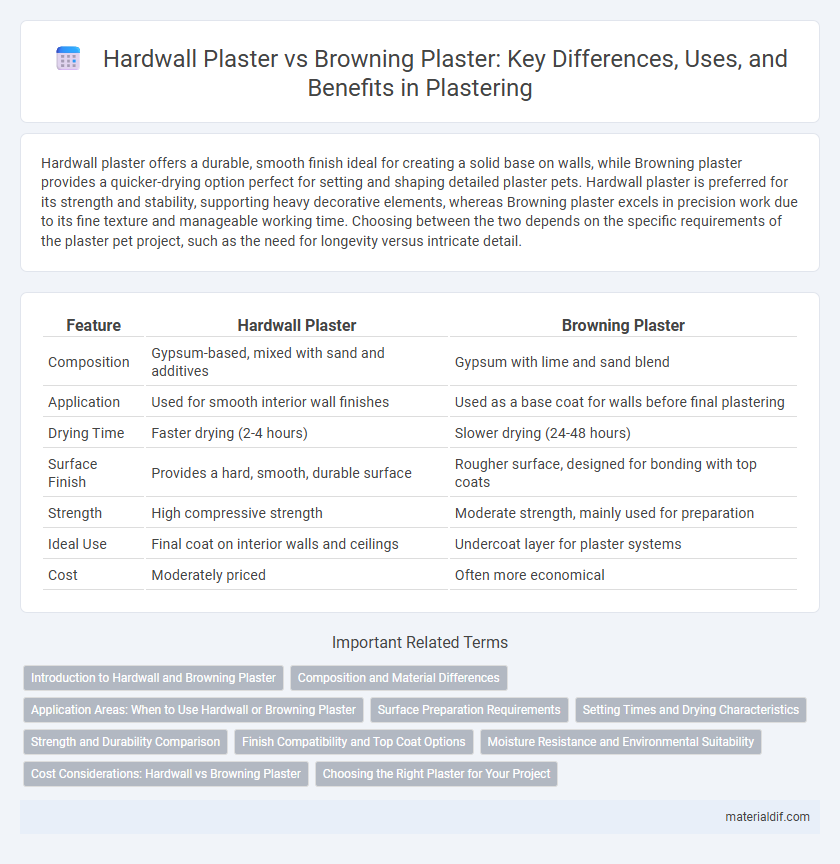Hardwall plaster offers a durable, smooth finish ideal for creating a solid base on walls, while Browning plaster provides a quicker-drying option perfect for setting and shaping detailed plaster pets. Hardwall plaster is preferred for its strength and stability, supporting heavy decorative elements, whereas Browning plaster excels in precision work due to its fine texture and manageable working time. Choosing between the two depends on the specific requirements of the plaster pet project, such as the need for longevity versus intricate detail.
Table of Comparison
| Feature | Hardwall Plaster | Browning Plaster |
|---|---|---|
| Composition | Gypsum-based, mixed with sand and additives | Gypsum with lime and sand blend |
| Application | Used for smooth interior wall finishes | Used as a base coat for walls before final plastering |
| Drying Time | Faster drying (2-4 hours) | Slower drying (24-48 hours) |
| Surface Finish | Provides a hard, smooth, durable surface | Rougher surface, designed for bonding with top coats |
| Strength | High compressive strength | Moderate strength, mainly used for preparation |
| Ideal Use | Final coat on interior walls and ceilings | Undercoat layer for plaster systems |
| Cost | Moderately priced | Often more economical |
Introduction to Hardwall and Browning Plaster
Hardwall plaster offers a robust, durable finish ideal for exterior walls and high-impact areas due to its cement-based composition and quick setting properties. Browning plaster, commonly used for internal wall preparation, provides a smooth, even surface that enhances paint adhesion and reduces the need for multiple coats. Both materials play distinct roles in construction, with Hardwall focusing on strength and weather resistance, while Browning emphasizes surface refinement before final decoration.
Composition and Material Differences
Hardwall plaster primarily consists of high-quality gypsum mixed with sand and lime, resulting in a durable and smooth finish suitable for exterior surfaces. Browning plaster incorporates a blend of lime, sand, and clay, offering enhanced breathability and flexibility, which makes it ideal for interior applications requiring moisture regulation. The key material difference lies in Hardwall's superior hardness and weather resistance compared to Browning plaster's softer, more porous composition that supports paint adhesion and vapor permeability.
Application Areas: When to Use Hardwall or Browning Plaster
Hardwall plaster is ideal for exterior walls and high-impact indoor areas due to its durability and resistance to moisture, making it suitable for basements and bathrooms. Browning plaster excels in interior walls and ceilings where a smooth, fine finish is desired, commonly used in bedrooms and living rooms. Choosing between Hardwall and Browning plaster depends on environmental exposure and the required surface finish quality.
Surface Preparation Requirements
Hardwall plaster requires a clean, dust-free, and slightly moistened substrate to ensure optimal adhesion and reduce cracking risks. Browning plaster demands less surface dampness but necessitates thorough removal of grease, paint, and laitance to achieve a strong mechanical key. Proper surface preparation for both materials directly influences finish durability and plaster performance in various construction environments.
Setting Times and Drying Characteristics
Hardwall plaster typically sets faster than Browning plaster, with initial setting times around 15-20 minutes compared to Browning's 20-30 minutes, making it suitable for quick application projects. Browning plaster dries more slowly, allowing for longer working times and reducing the risk of cracking, which is beneficial for detailed finishing work. Both types require proper curing to achieve optimal strength, but Hardwall plaster's rapid set demands careful timing to avoid premature drying.
Strength and Durability Comparison
Hardwall plaster exhibits superior strength and durability compared to Browning plaster, making it ideal for high-traffic areas and exterior applications. The dense composition of Hardwall plaster enhances resistance to cracking and impact damage, ensuring long-lasting structural integrity. Browning plaster, while easier to apply and finish, generally lacks the robustness and longevity required for demanding environments.
Finish Compatibility and Top Coat Options
Hardwall plaster offers a smooth, durable surface ideal for a wide range of finish applications, including paint, wallpaper, and various textured coatings, providing excellent top coat compatibility. Browning plaster, designed primarily as a base or undercoat, excels in creating a strong, even substrate but requires additional finishing layers for a polished look, typically paired with skim coats or specialized top coats. Both plasters support versatile decorative options, but Hardwall plaster's inherent smoothness enhances finish adhesion and reduces the need for extensive preparation before applying top coats.
Moisture Resistance and Environmental Suitability
Hardwall plaster offers superior moisture resistance due to its dense composition, making it ideal for high-humidity environments such as bathrooms and basements. Browning plaster, while less moisture-resistant, excels in applications requiring breathability and environmental adaptability, suitable for older buildings with natural ventilation. Choosing between Hardwall and Browning plaster depends on balancing moisture exposure with the building's need for vapor permeability to prevent mold and structural damage.
Cost Considerations: Hardwall vs Browning Plaster
Hardwall plaster generally costs more due to its durability and labor-intensive application process compared to Browning plaster, which is more budget-friendly and used primarily for non-structural finishes. Material expenses for Hardwall include higher-grade aggregates and additives to enhance strength, while Browning plaster components are simpler and less expensive. Choosing between the two often depends on project budget, with Hardwall preferred for long-term investment despite its upfront cost.
Choosing the Right Plaster for Your Project
Hardwall plaster offers a durable and smooth finish ideal for high-traffic areas and walls requiring extra strength, while Browning plaster is lightweight and easier to apply, making it suitable for quick repairs and decorative work. Consider surface type, project scale, and drying times; Hardwall plaster typically requires longer curing but provides a more robust base, whereas Browning plaster sets faster with good adhesion on various substrates. Selecting the right plaster depends on balancing durability needs with application speed and finish quality for your specific project requirements.
Hardwall plaster vs Browning plaster Infographic

 materialdif.com
materialdif.com